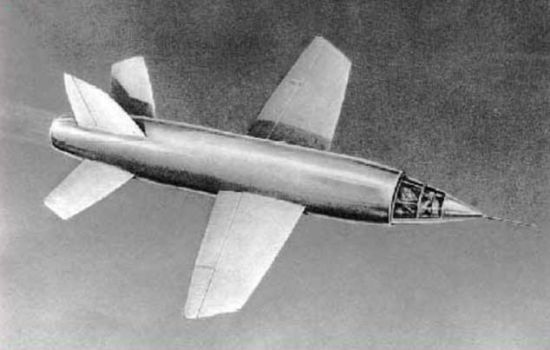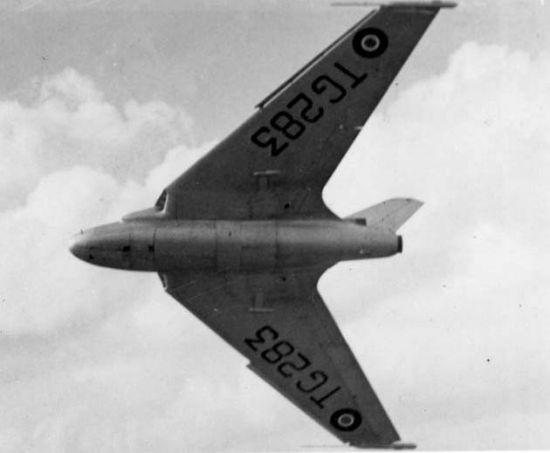|
||||||||||
|
|
||||||||||
|
||||||||||
|
|
||||||||||
The most ambitious British project to explore supersonic flight began as early as 1942 when the Air Ministry and Ministry of Aviation contracted Miles Aircraft to build a research aircraft. The project was considered top secret given its development during the midst of World War II, and it was not until many years later that many details of its design became known to the public. The ambitious specifications for this new aircraft called for a top speed of over 1,000 mph (1,610 km/h) during level flight and an initial climb rate of 24,000 ft/min (7,315 m/min).

Miles responded to this need with a revolutionary design called the M.52. Bearing a resemblance to the contemporary Bell X-1, the M.52 mated a bullet-shaped fuselage to very thin razor-sharp unswept wings to reduce the wave drag that occurs in transonic flight. Another key feature incorporated into the M.52 was the use of an all-moving horizontal tailplane as opposed to the fixed stabilizer and moving elevator used on conventional subsonic aircraft. This development showed that Miles engineers understood the problems conventional tail designs experience near the speed of sound because of the formation of shock waves that reduce control effectiveness. This problem was also encountered on the X-1, and Bell designers adopted the same solution.
One significant difference between the two planes was the propulsion system. While the X-1 was rocket-powered, the M.52 was to incorporate a jet engine designed by Frank Whittle and fitted with an afterburner to increase thrust. The novel design also included a fan located in front of and powered by the jet to accelerate more air through ducts surrounding the engine and further increase thrust, much like a modern-day turbofan. Airflow to the engine was provided through an intake at the nose of the plane. This advanced inlet included a conical centerbody to generate a shock wave and slow the incoming air to subsonic speeds, a concept later used on many other early jets such as the MiG-21.
Design of the M.52 was nearly complete by 1944, and the UK government approved the construction of three prototypes. By the end of World War II in mid-1945, the first prototype was over half-built and may have been ready to begin flight testing within a year. Unfortunately, a new government had been elected in 1945 when conservative Prime Minister Winston Churchill was defeated by the Labour party. The new Labour government felt that too much money was being wasted on defense-related projects now that the war had been won, and widespread funding cuts were instituted. One of the projects eliminated was the M.52, cancelled in February 1946 by Sir Ben Lockspeiser, the Director of Scientific Research.
One of the reasons often cited for this decision was captured German data on high-speed aerodynamics that indicated swept wing designs were superior in supersonic flight. Based on this information, it was concluded that attempting to break the sound barrier in a straight wing design like the M.52 was foolish and could potentially result in the fatal loss of the plane and pilot. Unfortunately for the British, the Americans soon proved this belief wrong when the X-1 broke the sound barrier using a thin straight wing design very similar to that of the M.52. This success led to widespread criticism of the UK government throughout the British press, and many argued that the M.52 program should be revived.
This effort was to no avail, but the British government had not completely abandoned high-speed research. Even as the M.52 was nearing cancellation, the Air Ministry contracted de Havilland to construct a transonic research aircraft in October 1945. The primary goal of this plane was to study the flight characteristics of swept wings at subsonic speeds and provide data for the Comet jet-powered airliner. The design that finally emerged was known as the D.H.108 Swallow. This aircraft used essentially the same fuselage as the de Havilland Vampire, Britain's first production fighter with a single jet engine. Attached to this fuselage was a completely new wing swept back 43° and full of elevon control surfaces instead of a traditional horizontal tail.

The first prototype was designed primarily for low-speed test flights and became airborne for the first time on 15 May 1946. The second prototype was of a slightly modified design with wing sweep increased to 45°. This aircraft was also equipped with new automatic slats on the wing leading edges and powered controls to improve controllability at higher speeds. This second prototype was designed for use at transonic speeds approaching Mach 1, and it was hoped the plane would set a new speed record.
Unfortunately, this aircraft was lost in a tragic crash on 27 September 1946 that killed pilot Geoffrey de Havilland, Jr., son of the company's founder. The plane was lost during a test flight leading up to the planned speed record. As the D.H.108 approached Mach 0.9, its structure began to fail sending the plane out of control. The aircraft broke up and its debris rained down upon Egypt Bay.
This fatal accident delayed further testing by nearly a year, and it was not until July 1947 that the third and final aircraft made its first flight. This prototype featured a longer, more pointed nose to reduce drag and allow higher speeds. It was this plane that became the first British aircraft to reach supersonic speeds. On 9 September 1948 with test pilot John Derry at the controls, the third D.H.108 reached Mach 1.0 while in a shallow dive from an altitude of 40,000 ft (12,190 m).
Unfortunately, the historic aircraft is no longer left to us today as it too was destroyed in a fatal crash. Both
the first and third prototypes were lost during flight test accidents in 1950, killing their pilots.
- answer by Jeff Scott, 17 October 2004
Related Topics:
When did Russia first break the sound barrier? Who did it and in what plane?
Who was the first person to fly Mach 2?
Read More Articles:


|
Aircraft | Design | Ask Us | Shop | Search |

|
|
| About Us | Contact Us | Copyright © 1997-2023 | |||
|
|
|||